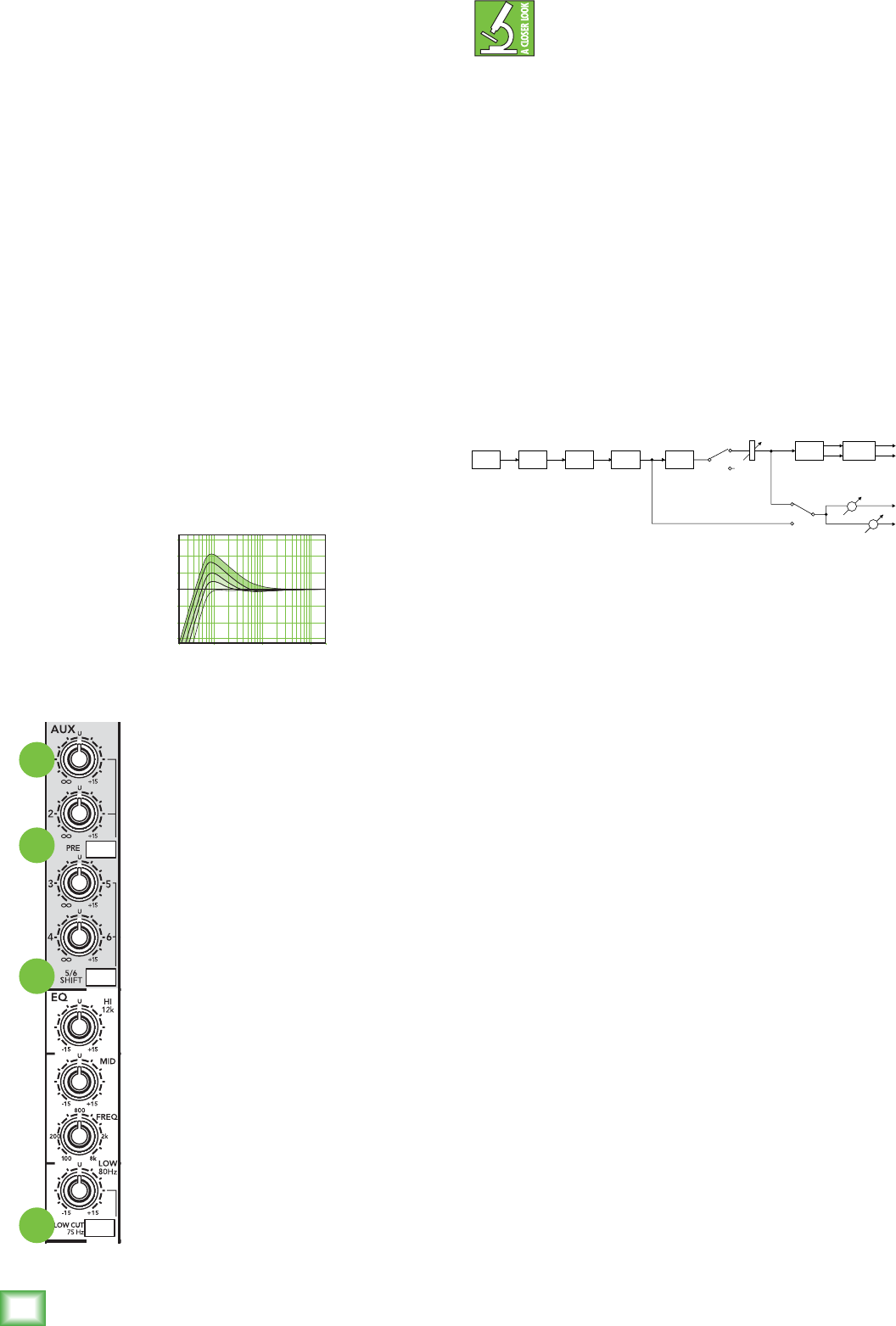
18
1604VLZ4
1604VLZ4
33. Low Cut
Thisswitch,oftenreferredtoasahighpasslter(all
dependsonhowyoulookatit),cutsbassfrequencies
below75Hzatarateof18dBperoctave.Thisain’tno
thrown-indime-storelter—an18dBperoctavecurve
requiresanelaboratecircuit.Nothingbutthebest.
Werecommendthatyouusethisoneverysound
sourceexceptkickdrum,bassguitar,orbassysynth
patches.Theseaside,thereisn’tmuchdowntherethat
youwanttohear,andlteringitoutmakesthelowstuff
youdowantmuchmorecrispandtasty.Notonlythat,
butlowcutcanhelpreducethepossibilityoffeedback
inlivesituations,andithelpstoconserveamplier
power.
Withlowcut,youcansafelyboostlowEQ.Many
times,bassshelvingEQcanreallybenetvoices.
Troubleis,addinglowEQalsobooststhesubsonic
debris:Stagerumble,michandlingclunks,windnoise
andbreathpops.Lowcutremovesallthatdebrissoyou
canboostthelowEQwithoutblowingyoursubwoofers.
Here’safrequencycurveoflowEQcombinedwith
lowcut:
34. Aux 1, 2, 3, & 4
Thesefourknobstapaportionofeach
channel’ssignal,mixthemtogetherand
sendthemtotheauxsend[6]outputs.
Theyareoffwhenturnedfullydown,
deliverunitygainatthecenterdetent,
andcanprovideupto15dBofgainturned
fullyup.Chancesareyou’llneverneed
thisextragain,butit’snicetoknowit’s
thereifyoudo.
Theauxsendoutputsarethenpatched
toparalleleffectsprocessorinputsorstage
monitorampinputs.Auxsends1and2
levelsarecontrollednotonlybythe
channel’sauxknobs,butalsobythe
auxsend[49]masterknobs.
Auxsendscanalsobeusedto
generateseparatemixesforrecording
or“mix-minuses”forbroadcast.Byusing
aux1or2inthepre[35]mode,these
mixlevelscanbeobtainedindependently
ofachannel’sfader[25]settings.
20
Hz
100
Hz
1k
Hz
10k
Hz
20k
Hz
–15
–10
–5
0
+5
+10
+15
33
36
34
35
Werecommendgoingintoastereoreverbin
monoandreturninginstereo.Wehavefound
thatonmost“stereo”reverbs,thesecond
inputjusttiesupanextraauxsendandaddsnothing
tothesound.Thereareexceptions,sofeelfreetotryit
bothways.Shouldyouchoosetousetwoauxsends,
usethe“odd”aux(1,3or5)tofeeditsleftinput
andthe“even”aux(2,4or6)tofeedtherightinput.
Remember,ifyou’realsodealingwithastereosource
signal,you’llwanttofollowthesides—usetheoddaux
onthechannelcarryingtheleftsideandtheevenaux
onthechannelcarryingtheright.
35. Pre
Thisswitchdeterminesthetappointofaux1and2.
Generally,“post”sendsareusedtofeedeffectsdevices,
and“pre”sendsareusedtofeedyourstagemonitors.
Seethe“Prevs.Post”diagrambelow.Aux3through6
arealwaysinpostmode.
Inpostmode(switchup),aux1and2willfollow
theEQ[32],lowcut[33],fader[25],andmute[30]
settings.Ifyoufadethechannel,youfadethesend.
Thisisamustforeffectssends,sinceyouwant
thelevelsofyour“wet”signalstofollowthelevel
ofthe“dry.”
Inpremode(switchdown),aux1and2followthe
gainandlowcutsettingsonly.EQ,pan,fader,andmute
settingshavenoeffectonthepresends.Thisisthe
preferredmethodforsettingupstagemonitorfeeds
—they’llbecontrolledindependentlyofthefaderand
mutemoves.
36. 5/6 Shift
Don’tletthefactthatthere’sonlyfourauxknobs
perchannelfoolyou—the1604VLZ4hassixaux
sends[6].Withthis5/6shiftswitchup,theknobs
labeledaux3andaux4delivertheirsignalstoaux
send3and4outputs.Withthisswitchdown,the
signalsappearattheauxsend5and6outputs.
Werecommendthatauxsend3and4bepatchedinto
your“utility”effects,likeashortreverbandslapdelay;
effectsyouuseallthetime.Useauxsend5and6for
“exotic”effects,likeharmonizersandmulti-tapdelays;
theyarenotlikelytobeusedasoften.
INPUT TRIM INSERT
LOW
CUT
EQ
PAN ASSIGN
MUTE
FADER
'POST' SIGNAL
'PRE' SIGNAL
PRE SWITCH
AUX 1
AUX 2


















